|
|
Mercedes S-class (W221)
Debut: 2005
Maker: Mercedes-Benz
Predecessor: S-class (W220) |
|
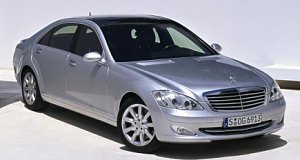 From
W220 to W221 might be a small increment, but that is enough to put the
S-class on the top of the luxurious car ranking again. In fact, ever
since I watch cars, Mercedes S-class has been dominating the luxury
segment. It is the label that every other premium marques want to - but
fail to – challenge. The previous S-class W220 sold a total of 485,000
units in its 7 years life. That is an amazing figure for such an
expensive vehicle. Even in its final full year, it still sold 84,100
units worldwide, accounting for 35% of the segment and, unsurprisingly,
once again by far the best selling luxurious car in the world. From
W220 to W221 might be a small increment, but that is enough to put the
S-class on the top of the luxurious car ranking again. In fact, ever
since I watch cars, Mercedes S-class has been dominating the luxury
segment. It is the label that every other premium marques want to - but
fail to – challenge. The previous S-class W220 sold a total of 485,000
units in its 7 years life. That is an amazing figure for such an
expensive vehicle. Even in its final full year, it still sold 84,100
units worldwide, accounting for 35% of the segment and, unsurprisingly,
once again by far the best selling luxurious car in the world.
However, no matter how great the W220, it did show signs of aging in
its final years – the cabin quality fell below class standard, the
sleek appearance started getting old, and the eco-friendly 3-valve per
cylinder V6 / V8 engines lack power to fend off the challenge from BMW
750i. Therefore Mercedes improved these areas in the new generation
W221. Unsurprisingly, it also took this opportunity to increase cabin
space, reduce NVH and upgrade all the sophisticated safety and comfort
technologies.
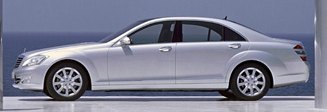 In
terms of design, in my opinion the new W221 S-class is an improvement
from W220. The old car's sleek and sporty shape was handsome, but it
lacked elegant details to match its luxury status. By luxurious car
standard its design was almost too raw and pre-matured. In contrast,
the new S-class might look more conservative – even have some shadows
of Maybach - but the shape is imposing and the details are fine and
elegant. Most important, it is still recognizable a big Mercedes. In
terms of design, in my opinion the new W221 S-class is an improvement
from W220. The old car's sleek and sporty shape was handsome, but it
lacked elegant details to match its luxury status. By luxurious car
standard its design was almost too raw and pre-matured. In contrast,
the new S-class might look more conservative – even have some shadows
of Maybach - but the shape is imposing and the details are fine and
elegant. Most important, it is still recognizable a big Mercedes.
To offer more room inside, Mercedes stretched the wheelbase by 70 mm,
now exceeding BMW 7-Series by 40 mm. The length, width and height are
increased by 33 mm, 16 mm and 29 mm respectively. Open the doors, you
will find it offers more room than anybody needs. It is also more
comfortable than any other mass production luxurious cars. First of
all, the cabin is really very, very quiet. It isolates the engine and
the road effectively. Then you can enjoy the superbly comfortable seats
– it is the most comfortable seats in the industry (excluding the
airline first class seat of Maybach, of course), which is heated,
ventilated, perfectly cushioned, incorporating a massager and side
bolsters that inflat automatically during hard cornering to hold you
firmly in place. Brilliant.
 Mercedes'
intention to regain the lead in quality is apparent in the cabin of the
new S-class. The dashboard, door panels and transmission tunnel are
impeccably built and trimmed. The attention to details surpasses the
level of Audi. Many switches are chromed. Soft theater lighting
enhances the ambience at night. At the same time, the cabin feels
high-tech – the speedometers look like analogue dials but they are
actually the image in a high resolution LCD screen. At night, the
screen can be changed to display the infrared image of the road ahead
(in case the optional “Night View” equipment is selected). The center
console has another big LCD screen. It displays the information from
the “Command” system – a multi-control system for audio, video,
sat-nav, phone, climate control etc. It is Mercedes' version of i-Drive
or MMI, but the control is more initiative than both BMW and Audi's.
Unfortunately, to house the LCD screen without light reflection,
Mercedes came up with a dashboard design similar to BMW 7-Series. It
also copied BMW's idea to move the gear lever to the steering column
and place a big armrest + rotary control knob of the Command system in
front of the arm rest. Luckily, this aluminum control knob looks
high-tech and there is a wrist pad provided – just like the wrist pad
in behind your mouse – to comfort your hand. Open the wrist pad, a
mobile phone keyboard is revealed, wow.... This environment combines
the best quality with the best technologies. Mercedes'
intention to regain the lead in quality is apparent in the cabin of the
new S-class. The dashboard, door panels and transmission tunnel are
impeccably built and trimmed. The attention to details surpasses the
level of Audi. Many switches are chromed. Soft theater lighting
enhances the ambience at night. At the same time, the cabin feels
high-tech – the speedometers look like analogue dials but they are
actually the image in a high resolution LCD screen. At night, the
screen can be changed to display the infrared image of the road ahead
(in case the optional “Night View” equipment is selected). The center
console has another big LCD screen. It displays the information from
the “Command” system – a multi-control system for audio, video,
sat-nav, phone, climate control etc. It is Mercedes' version of i-Drive
or MMI, but the control is more initiative than both BMW and Audi's.
Unfortunately, to house the LCD screen without light reflection,
Mercedes came up with a dashboard design similar to BMW 7-Series. It
also copied BMW's idea to move the gear lever to the steering column
and place a big armrest + rotary control knob of the Command system in
front of the arm rest. Luckily, this aluminum control knob looks
high-tech and there is a wrist pad provided – just like the wrist pad
in behind your mouse – to comfort your hand. Open the wrist pad, a
mobile phone keyboard is revealed, wow.... This environment combines
the best quality with the best technologies.
 As
usual, the S-class is loaded with countless of equipments and
electronic assistance. Safety features include PRE-SAFE system (which
automatically tighten seat belts and close windows in prior to a
possible crash), Brake Assist Plus (when the front radar detects the
vehicle in front is too close, it warn the driver and increase brake
booster), Distronic Plus (a cruise control which keep a minimum
distance from cars in front and rear, also help parking) and the
aforementioned Night View infrared camera. As
usual, the S-class is loaded with countless of equipments and
electronic assistance. Safety features include PRE-SAFE system (which
automatically tighten seat belts and close windows in prior to a
possible crash), Brake Assist Plus (when the front radar detects the
vehicle in front is too close, it warn the driver and increase brake
booster), Distronic Plus (a cruise control which keep a minimum
distance from cars in front and rear, also help parking) and the
aforementioned Night View infrared camera.
From mechanical point of view, however, the W221 is a small evolution
from W220. Its new shape body keeps drag coefficient unchanged at 0.27.
It uses aluminum bonnet, front fenders, doors and boot lid to limit
weight gain to merely 65 kg. It retains the basic suspensions of its
predecessor, i.e. 4-link up front and multi-link at the rear. It
continues to offer Airmatic DC variable air spring / variable ride
height / adaptive damping, though the calibration is further refined.
Active Body Control (an active anti-roll system) is again standard on
S600 and optional to other models. Besides, the speed-sensitive
hydraulic assistance rack and pinion steering remains unchanged. These
systems worked so brilliantly in the old S-class and today they are
still the most sophisticated in the industry, no wonder Mercedes wasted
no effort to alter them.
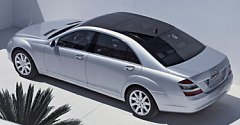 Instead
of chassis, more attention has been paid to the powertrain. The new
S-class finally replaces the long-serving 3-valve-per-cylinder V6 and
V8 with a new generation 4-valve V6 / V8 family. This start from the
272 hp 3.5-litre V6 S350 to the new 388 hp 5.5-litre V8 S500 (or S550
for USA), and later
next year, the 510 hp 6.3-litre AMG V8. The new engines are benefited
from more valves, dual continuous VVT and variable intake manifolds,
also increased capacity, no wonder they produce significantly more
power than before – for example, the new S500 gains 82
horsepower. Instead
of chassis, more attention has been paid to the powertrain. The new
S-class finally replaces the long-serving 3-valve-per-cylinder V6 and
V8 with a new generation 4-valve V6 / V8 family. This start from the
272 hp 3.5-litre V6 S350 to the new 388 hp 5.5-litre V8 S500 (or S550
for USA), and later
next year, the 510 hp 6.3-litre AMG V8. The new engines are benefited
from more valves, dual continuous VVT and variable intake manifolds,
also increased capacity, no wonder they produce significantly more
power than before – for example, the new S500 gains 82
horsepower.
With new found power, now S500 becomes almost a sports sedan. Its V8 is
powerful, flexible yet refined. At low rev it spins silently. Once you
ask from it, it delivers serious power and torque, even more so than
the recent BMW 750i (which is not only heavier than S500, but produces
20 less horsepower and 30 less pound-foot of torque). The 7-speed
7G-Tronic automatic transmission also gives it a slight advantage in
acceleration. Mercedes believes the S500 can accelerate from 0 to 60
mph in merely 5.2 seconds, that's half a second quicker than its
arch-rival !
For those who ask for even more, the flagship S600 is the natural
choice. Ridiculously, its 5.5-litre twin-turbo V12 is the only survivor
of the outgoing 3-valve-per-cylinder series engine, but it can still
crank out 517 horsepower and an astonishing 612 lbft of torque, both
figures are slightly higher than the outgoing S600 but not Maybach.
0-60 mph can be done in a supercar-rivaling 4.5 seconds, even though
the long-wheelbase-compulsory model tips the scale at 2.1 ton !
Moreover, it still employs the old 5-speed automatic because it is the
only transmission can handle so much torque.
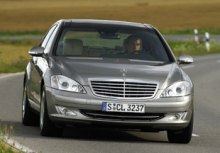 In terms
of comfort, refinement, quality, technologies and performance, the new
big Mercedes set new standards for the class. How about handling and
ride? evaluating handling in isolation, BMW 7-series may have a slight
advantage. But combining handling and ride together, there is simply no
other luxurious car can rival the S-class. This statement has been true
to the outgoing W220, and even "truer" to the new S-class. Despite of
its size and weight, the S-class feels surprisingly nimble to drive. It
can attack corners with the composure of a much smaller car, especially
if ABC is equipped, where its turn-in becomes sharper and body roll
becomes almost non-existent. The steering wheel might feels light and
vague at straight-ahead (to filter harshness that could ruin cruising
refinement), but once you turn it either side, it feels natural,
precise and quick. Push the S-class to the limit, it displays amazing
level of neutrality, followed by mild understeer and then the ESP digs
in smoothly to correct things. This car is so enjoyable to drive. In terms
of comfort, refinement, quality, technologies and performance, the new
big Mercedes set new standards for the class. How about handling and
ride? evaluating handling in isolation, BMW 7-series may have a slight
advantage. But combining handling and ride together, there is simply no
other luxurious car can rival the S-class. This statement has been true
to the outgoing W220, and even "truer" to the new S-class. Despite of
its size and weight, the S-class feels surprisingly nimble to drive. It
can attack corners with the composure of a much smaller car, especially
if ABC is equipped, where its turn-in becomes sharper and body roll
becomes almost non-existent. The steering wheel might feels light and
vague at straight-ahead (to filter harshness that could ruin cruising
refinement), but once you turn it either side, it feels natural,
precise and quick. Push the S-class to the limit, it displays amazing
level of neutrality, followed by mild understeer and then the ESP digs
in smoothly to correct things. This car is so enjoyable to drive.
However, what made the S-class so different to rivals is: beside that
remarkable handling, the big Mercedes offers superb ride comfort
simultaneously. Such level of completeness is still unrivalled by BMW,
Audi, Jaguar, Lexus and even Bentley. The S-class' Airmatic suspension
is still the most effective adaptive suspensions in the world. It deals
well with almost all kinds of surfaces and speed, resulting in a supple
and quiet ride.
S-class is always the symbol of Mercedes-Benz. Its success is highly
crucial to the image of the company. Now the engineers responsible for
the new S-class can finally have a good sleep, for they have created
the best luxurious car in the world, once again.
|
| The
above report was last updated on 21 Oct 2005. All Rights Reserved. |
|
S65 AMG
|
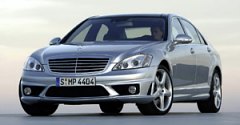 From
the old S65 to new S65, one thing hasn’t changed: its heart. This is
AMG’s most fearsome power plant, the 6.0-litre twin-turbo V12. Based on
the long-serving Mercedes 3-valve-per-cylinder V12, it might not be
state of the art. It doesn’t have any variable valve timing, direct
injection or the like, but it has plenty of displacement and a pair of
turbochargers sucking 1.5 bar boost pressure. A simple calculation will
find this equals to 15 litres of capacity ! no wonder it can pump out
612 horsepower and a mind-blowing 1000 Nm of torque ! From
the old S65 to new S65, one thing hasn’t changed: its heart. This is
AMG’s most fearsome power plant, the 6.0-litre twin-turbo V12. Based on
the long-serving Mercedes 3-valve-per-cylinder V12, it might not be
state of the art. It doesn’t have any variable valve timing, direct
injection or the like, but it has plenty of displacement and a pair of
turbochargers sucking 1.5 bar boost pressure. A simple calculation will
find this equals to 15 litres of capacity ! no wonder it can pump out
612 horsepower and a mind-blowing 1000 Nm of torque !
Look at the torque curve and you will be astonished: from 2000 rpm to
4000 rpm the curve is completely flat. What does this mean? It means
AMG artificially limited the peak torque to 1000 Nm. Unrestricted, it
could have reached 1200 Nm, but unfortunately Mercedes group has no
transmission capable of handling so much torque. The strongest
transmission it has is the old generation 5-speed automatic, which can
withstand 1000 Nm reliably. That’s why S65 AMG does not use the latest
7G-Tronic but the older 5-speeder with AMG Speedshift program.
Containing the same wine is a new bottle. W221 definitely looks sharper
and more elegant than the organic W220, especially in AMG form. It got
a very stylish front bumper, aero tweaks, 5-spoke 19-inch wheels and
four chromed exhaust pipes, but the overall design theme still follows
AMG’s tradition: understated beauty. Few outsiders could believe this
is the world’s fastest production sedan. Mercedes talks of 0-60 mph in
4.3 seconds and 0-100 mph in 9 seconds. As long as in Autobahn, it
could eat BMW M5 for breakfast. No one knows how fast it could be if it
were not regulated to 155 mph. Maybe 200 mph, I think.
 Of
course, the 2.2-ton, long-wheelbase limousine is not the right car to
chase M5 in the twisty. It lacks the agility, cornering prowess and
intimate feel to do so. People should understand that it is an Autobahn
rocket rather than a Nurburgring hero. To exploit its superior
performance you should drive it on highway, give it plenty of space and
long straight. In this way, you can enjoy its neverending power and
torque. Of
course, the 2.2-ton, long-wheelbase limousine is not the right car to
chase M5 in the twisty. It lacks the agility, cornering prowess and
intimate feel to do so. People should understand that it is an Autobahn
rocket rather than a Nurburgring hero. To exploit its superior
performance you should drive it on highway, give it plenty of space and
long straight. In this way, you can enjoy its neverending power and
torque.
At the same time, you will be amazed by the luxury and refinement it
offers. Sure, there is more tire roar and small harshness transmitted
from the low profile tires, but the car is so stable and relaxing at
high speed. Its Active Body Control limits roll and pitch effectively.
Its traction and stability control avoid wheelspin and oversteer. Its
ceramic composite brake discs and twin sliding calipers kill speed
quickly. This mean all 612 horses are tamed to serve you, allowing you
to enjoy the ventilated massaging seat at 250 km/h. Should you corner
too aggressively, the seat bolsters will inflate to hold you tight.
However, the AMG is neither a real limousine nor a real sports sedan.
Those pursuing driving excitement is better to look for a M5 or E63
AMG. Those pursuing luxury will be better served in the S600, which
also provides most of the AMG’s performance. Perhaps S65 AMG goes too
far. There are always some people asking for neverending horsepower to
show their superiority over others - no matter measured by performance
or by wealth. S65 AMG is this kind of car. A statement of excellence. A
statement of superiority. However, it is not necessarily the best car
in the world.
|
| The
above report was last updated on 18 May 2006. All Rights Reserved. |
|
S63 AMG
|
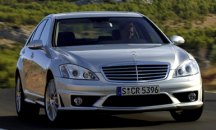 There
are plenty of fast S-class. If S500 is not fast enough for you, you can
opt for S600, S63 AMG and S65 AMG. Each of them offers in excess of 500
horsepower and 0-60 mph acceleration in no more than 4 and a half
seconds. Some may think it is unnecessary to have 3 super performance
models in the S-class. Mercedes argues that they have different
character – S600 biases towards comfort, S65 AMG is the ultimate
performance limousine while S63 AMG is the sportiest. There
are plenty of fast S-class. If S500 is not fast enough for you, you can
opt for S600, S63 AMG and S65 AMG. Each of them offers in excess of 500
horsepower and 0-60 mph acceleration in no more than 4 and a half
seconds. Some may think it is unnecessary to have 3 super performance
models in the S-class. Mercedes argues that they have different
character – S600 biases towards comfort, S65 AMG is the ultimate
performance limousine while S63 AMG is the sportiest.
Yes, sportiest does not mean the fastest. In isolation, the 525
horsepower 6.2-liter naturally aspirated V8 is already very powerful –
some 75 horses more than Audi S8, for example. But S65 AMG has 612 hp
on tap and an overwhelming advantage in torque, i.e. 738 lbft versus
465 lbft. This mean the top model can accelerate from rest to 100 mph
in an estimated 0.8 seconds quicker than S63 despite that its
transmission has two less ratios. Nevertheless, performance is not the
only thing car enthusiasts concerned. More important is how it deliver
the performance in terms of sound, response and agility. S63 has
several
advantages to S65: firstly, it is derived from the short-wheelbase
platform, saving 130mm between the axles. This translate to higher
cornering agility. Secondly, its front axle carries 100 or so kilograms
less than the bigger car, thanks to the weight difference between the
V8 and twin-turbo V12 and their transmissions. Again this make it feels
more nimble than the S65. Thirdly, the naturally aspirated V8 is more
delicious in all subjective aspects – it sounds exciting, it loves to
rev and it responds instantly to throttle input. Turbocharged engines
can hardly provide these qualities.
 The control system of S63 is
also sportier than S65. It provides 3 modes – Comfort, Sport and
Manual, which alter the gearshift speed of the 7G-Tronic transmission,
the stiffness of Active Body Control suspensions and the throttle
response of the engine. In contrast, the control system of S65 lacks
the ability of changing throttle response. In manual mode, S63 can make
50 percent faster gearshifts while S65 is only 35 percent faster.
Moreover, the manual mode of S65 affects transmission only, while the
same mode in S63 stiffens suspensions further. If you are willing to
use Manual mode at the price of ride quality, you will find S63
noticeably sportier. The control system of S63 is
also sportier than S65. It provides 3 modes – Comfort, Sport and
Manual, which alter the gearshift speed of the 7G-Tronic transmission,
the stiffness of Active Body Control suspensions and the throttle
response of the engine. In contrast, the control system of S65 lacks
the ability of changing throttle response. In manual mode, S63 can make
50 percent faster gearshifts while S65 is only 35 percent faster.
Moreover, the manual mode of S65 affects transmission only, while the
same mode in S63 stiffens suspensions further. If you are willing to
use Manual mode at the price of ride quality, you will find S63
noticeably sportier.
However, no matter how brilliant the ABC and control system are, they
cannot hide the laws of physics completely. This car measures in excess
of 3 meters in wheelbase and weighs 2 tons. While it is surprisingly
nimble for its size, it cannot match the smaller E63 and CLS63 which
use the same engine, or the CL63 with lower center of gravity and
shorter wheelbase. It works well on highway or fast bends, thanks to
the outstanding high-speed stability, powerful ceramic brakes and
strong grip, but will you dare to push it in the twisty and power
slide it ? like S65, it works better as an Autobahn express. Only in
this way its superior refinement and ride quality will shine. However,
on the increasingly congested European highways, most people will find
a regular S500 fast enough.
Large performance limousines are always the most difficult
cars to justify. S63 faces the same identity problem as S65 and Audi
S8. So far
only Maserati Quattroporte has proved that big limousines can be
entertaining to drive.
|
| The
above report was last updated on 25 Oct 2006. All Rights Reserved. |
|
S400 Hybrid
|
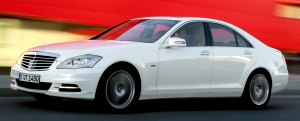 Mercedes’
first take on hybrid technology is conservative. Unlike the rivalry
Lexus LS600h, S400 Hybrid is a “mild hybrid” instead of a “full
hybrid”. Its 3.5-liter petrol V6 is assisted by a small electric motor
offering only 20 horsepower, therefore the car cannot run in pure
electric mode. However, you cannot underestimate its effectiveness.
Compare with the regular S350, its EU combined fuel economy is improved
from 27.9 to 35.7 mpg, while CO2 emission
drops from 242 to 186 g/km. Mercedes proudly claims it is greener than
LS600h (30.3 mpg and 219 g/km), although they rest on very different
performance levels. Mercedes’
first take on hybrid technology is conservative. Unlike the rivalry
Lexus LS600h, S400 Hybrid is a “mild hybrid” instead of a “full
hybrid”. Its 3.5-liter petrol V6 is assisted by a small electric motor
offering only 20 horsepower, therefore the car cannot run in pure
electric mode. However, you cannot underestimate its effectiveness.
Compare with the regular S350, its EU combined fuel economy is improved
from 27.9 to 35.7 mpg, while CO2 emission
drops from 242 to 186 g/km. Mercedes proudly claims it is greener than
LS600h (30.3 mpg and 219 g/km), although they rest on very different
performance levels.
The S400 Hybrid is not about performance. It takes 6.8 seconds to go
from 0-60 mph, just 0.1 second less than S350. However, the electric
motor’s 118 lb-ft of torque, available right from startup, does boost
its low-down tractability a lot. If you normally drive in streets of
city, you might feel it considerably more powerful. Up the pace to
motorway speed, however, it feels much closer to its performance
figures suggested.
What makes it really special is packaging. This is probably the first
hybrid system that takes no more space than a conventional powertrain
and is therefore fully compatible with existing cars. You can hardly
find where its electric motor and battery pack locate, because the thin
disc-type motor is neatly laminated between the automatic transmission
and flywheel, and the small but efficient Lithium-ion battery (supplied
by Continental) is placed in the engine compartment, taking the place
of the conventional battery. The battery doesn’t need a dedicated
cooling system because it makes use of the car’s air conditioning,
which is located just nearby. Such simplicity means any rear-drive
Mercedes can adopt this hybrid system in the future.
|
| The
above report was last updated on 19 Jun 2009. All Rights Reserved. |
|
S63 AMG Biturbo
|
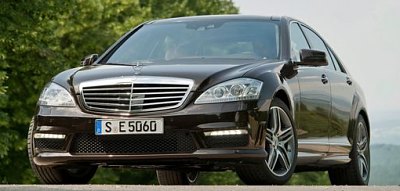 |
Turbocharging in the name of green
|
Since 2006, most AMG models
have been powered by the M156 6.2-liter V8. Until today, it is still
mightily powerful, flexible and great to listen. To performance
hardcore, there is absolutely no reason to replace it. Nevertheless,
like all other European car makers, Mercedes is struggling to
lower its average fleet emission in order to avoid tax penalty to be
imposed in the future. Its large-selling AMG fleet is no exception.
Starting from S63 AMG, all the "63" models will shift to a greener
5.5-liter biturbo V8 codenamed M157. More worrying is its roots. While
the M156 was a clean-sheet development by AMG itself, the M157 is
derived from the production Mercedes M273 V8, sharing its bore / stroke
dimensions and capacity of 5461cc. Will it lose the sharp throttle
response and thundering howl of the outgoing engine ? That is the most
worrying to us.
Before answering this question, let us hear the good news first. As
wished, the new engine is far cleaner than the old one. Thanks to the
reduced bore (by 4.2mm) and stroke (by 4.1mm), it generates less
frictional energy loss. The reduced capacity also leads to less pumping
loss. Furthermore, the new engine employs Mercedes' latest direct fuel
injection with spray-guided combustion and piezo injectors. In addition
to auto start-stop, the end result is a reduction of 27% in fuel
consumption and 29% in CO2 emission. On
the new S63 AMG, EU combined
consumption is now a remarkable 26.9 mpg, incredible for a 2-ton
limousine with 500-plus horsepower output !
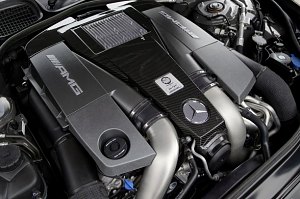
|
Those who praised the old 6.2 engine
for effortless performance should recalibrate their mind, because great
performance is easier than ever with the new engine.
|
Moreover, such greenness is not achieved in the expense of
performance. A pair of Garrett turbochargers are integrated with
exhaust manifolds to provide as quick response as possible. They
produce a maximum 1.0 bar of boost pressure, realizing 544 horsepower.
That's not a big departure from the previous 525hp, but you may notice
that it is now available at 5500 rpm instead of the previous 6800 rpm.
More telling is torque, which is lifted from 465 lb-ft to 590 lb-ft.
Moreover, the peak torque is now available continuously from 2000 to
4500 rpm, versus the previous peak at 5200 rpm. The strong bottom-end
torque means the new car can run at much lower rev than before, thus
explaining why it could achieve lower fuel consumption.
Officially, the new S63 AMG improves 0-60 sprint by only 0.1 second. In
the real world, however, the stronger torque – available right at any
gear and any rev – makes a noticeable difference subjectively. The
sensation of g-force is instantly available once you prod the throttle,
especially is the car fitted with Performance Pack. Thanks to
turbocharging technology, AMG can easily offer two states of tune from
basically the same engine. With a more aggressive engine mapping, the
Performance Pack car has maximum boost pressure lifted to 1.3 bar,
leading to 571 horsepower at 5500 rpm and a mind-blowing 664 lb-ft of
torque from 2250-3750 rpm. This software also lifts its electronic
speed regulation from the usual 155 mph to 186 mph, so that the owners
can
enjoy its extra performance on Autobahn. 0-60 mph sprint is reduced by
0.1 second further, although any more improvement is now down to
traction rather than power.
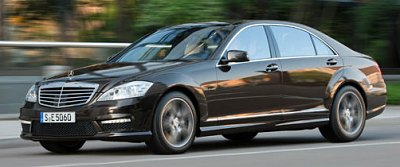
|
Still a remarkable combination of high
performance, endless luxury and grace.
|
So those who praised the old 6.2
engine for effortless performance should recalibrate their mind,
because great performance is easier than ever with the new engine. On
the downside, the turbocharged V8 does loses the instantaneous throttle
response of the old one, although by turbocharging standard it is very
good indeed. Having said that, only the purists may miss the old engine
for its sharpness. Ditto for sound. The 6.2 is unquestionably angrier,
more traditional in the way it sound, but the biturbo V8 is
surprisingly delicious to ears with its turbocharging bass at the
background overlaid with a hard-edged exhaust wail at full throttle.
Congratulation to AMG's acoustic engineers !
Apart from engine, the biggest change to S63 AMG is (finally) the
adoption of MCT (multi-clutch technology) gearbox from SL63. As we said
before, replacing the hydraulic torque converter of the 7-speed
automatic gearbox with a computer-actuated multi-plate wet clutch is a
delight to keen drivers as it means faster, more decisive gearshift,
even though it comes at the price of a slight reduction of smoothness.
Otherwise the S63 Biturbo differs from the old car by only a mild
facelift and recalibration of electronic aids to cope with the
increased torque. The suspensions, steering, brakes and rubbers are all
intact. It is still a remarkable combination of high performance,
endless luxury and grace.
|
| The
above report was last updated on 9 Aug 2010. All Rights Reserved. |
| Specifications
|
| General remarks |
| Layout |
| Chassis |
| Body |
| Length / width / height |
| Wheelbase |
| Engine |
| Capacity |
| Valve gears |
| Induction |
| Other engine features |
Max power
|
Max torque
|
| Transmission |
Suspension layout
|
| Suspension features |
Tires
|
| Kerb weight |
| Top speed |
| 0-60 mph (sec) |
| 0-100 mph (sec) |
|
| S350 |
Front-engined, RWD
|
| Steel monocoque |
Steel + aluminum
|
| 5076
/
1871
/ 1473 mm |
| 3035 mm |
V6, 90-degree
|
| 3498 cc |
DOHC 24 valves, VVT
|
| VIM |
| - |
272 hp
|
258 lbft
|
| 7-speed automatic |
F: 4-link
R: multi-link
|
| Adaptive air spring + damping |
235/55R17
|
| 1805 kg |
| 155 mph (limited) |
| 6.9 (c) |
| - |
|
| S500 (S550) |
Front-engined, RWD
|
| Steel monocoque |
Steel + aluminum
|
| 5076
/
1871
/ 1473 mm |
| 3035 mm |
V8, 90-degree
|
| 5461 cc |
DOHC 32 valves, VVT
|
| VIM |
| - |
388 hp
|
391 lbft
|
| 7-speed automatic |
F: 4-link
R: multi-link
|
| Adaptive air spring + damping |
235/55R17
|
1865 kg (LWB: 1910 kg)
|
| 155 mph (limited) |
5.2 (c) / 5.3* (LWB: 5.7**)
|
13.2* (LWB: 13.8**)
|
|
| S600 |
Front-engined, RWD
|
| Steel monocoque |
Steel + aluminum
|
| 5206
/
1871
/ 1473 mm |
| 3165 mm |
V12, 60-degree
|
| 5513 cc |
SOHC 36 valves
|
| Twin-turbo |
| Twin-spark |
517 hp
|
612 lbft
|
| 5-speed automatic |
F: 4-link
R: multi-link
|
Active body control
|
F: 255/45ZR18
R: 275/45ZR18 |
2105 kg
|
| 155 mph (limited) |
| 4.5 (c) / 4.2* / 4.4** |
| 9.7* / 10.8** |
|
|
|
|
|
| General remarks |
| Layout |
| Chassis |
| Body |
| Length / width / height |
| Wheelbase |
| Engine |
| Capacity |
| Valve gears |
| Induction |
| Other engine features |
Max power
|
Max torque
|
| Transmission |
Suspension layout
|
| Suspension features |
Tires
|
| Kerb weight |
| Top speed |
| 0-60 mph (sec) |
| 0-100 mph (sec) |
|
| S400 Hybrid |
Front-engined, RWD
|
| Steel monocoque |
Steel + aluminum
|
| 5076
/
1871
/ 1473 mm |
| 3035 mm |
V6, 90-degree, AC motor
|
| 3498 cc |
DOHC 24 valves, VVT
|
| VIM |
| - |
Engine:
279 hp
Motor: 20 hp
Combined: 299 hp / 6000 rpm |
Engine:
258 lbft
Motor: 118 lbft
Combined: 284 lbft / 2400 rpm |
| 7-speed automatic |
F: 4-link
R: multi-link
|
| Adaptive air spring +
damping |
235/55R17
|
1955 kg
|
| 155 mph (limited) |
| 6.8 (c) / 7.1* |
| 18.1* |
|
| S63 AMG |
Front-engined, RWD
|
| Steel monocoque |
Steel + aluminum
|
| 5076
/
1871
/ 1473 mm |
| 3035 mm |
V8, 90-degree
|
| 6208 cc |
DOHC 32 valves, DVVT
|
| VIM |
| - |
525 hp / 6800 rpm
|
465 lbft / 5200 rpm
|
| 7-speed automatic |
F: 4-link
R: multi-link
|
Active body control
|
F: 255/40ZR19
R: 275/40ZR19 |
1995 kg
|
| 155 mph (limited) |
| 4.4 (c) / 4.5* |
| 10.8* |
|
| S65 AMG |
Front-engined, RWD
|
| Steel monocoque |
Steel + aluminum
|
| 5206
/
1871
/ 1473 mm |
| 3165 mm |
V12, 60-degree
|
| 5980 cc |
SOHC 36 valves
|
| Twin-turbo |
| Twin-spark |
612 hp
|
738 lbft
|
| 5-speed automatic |
F: 4-link
R: multi-link
|
Active body control
|
F: 255/40ZR19
R: 275/40ZR19 |
2175 kg
|
| 155 mph (limited) |
| 4.3 (c) / 4.2* |
| 9.2* |
|
|
|
|
|
| General remarks |
| Layout |
| Chassis |
| Body |
| Length / width / height |
| Wheelbase |
| Engine |
| Capacity |
| Valve gears |
| Induction |
| Other engine features |
Max power
|
Max torque
|
| Transmission |
Suspension layout
|
| Suspension features |
Tires
|
| Kerb weight |
| Top speed |
| 0-60 mph (sec) |
| 0-100 mph (sec) |
|
| S63 AMG Biturbo |
Front-engined, RWD
|
| Steel monocoque |
Steel + aluminum
|
| 5122
/
1871
/ 1488 mm |
| 3035 mm |
V8, 90-degree (Perform. pack)
|
| 5461 cc |
DOHC 32 valves, DVVT
|
| Twin-turbo |
| DI |
544 hp (571 hp) / 5500 rpm
|
590 lbft / 2000-4500 rpm
(664 lbft / 2250-3750 rpm)
|
| 7-speed MCT |
F: 4-link
R: multi-link
|
Active body control
|
F: 255/40ZR19
R: 275/40ZR19 |
2045 kg
|
| 186 mph (limited) |
4.3 (c)
|
| - |
|
|
|
|
|
|
|
|
| Performance
tested by: *C&D,
**R&T |
Copyright©
1997-2010
by Mark Wan @ AutoZine
|
|
|
 From
W220 to W221 might be a small increment, but that is enough to put the
S-class on the top of the luxurious car ranking again. In fact, ever
since I watch cars, Mercedes S-class has been dominating the luxury
segment. It is the label that every other premium marques want to - but
fail to – challenge. The previous S-class W220 sold a total of 485,000
units in its 7 years life. That is an amazing figure for such an
expensive vehicle. Even in its final full year, it still sold 84,100
units worldwide, accounting for 35% of the segment and, unsurprisingly,
once again by far the best selling luxurious car in the world.
From
W220 to W221 might be a small increment, but that is enough to put the
S-class on the top of the luxurious car ranking again. In fact, ever
since I watch cars, Mercedes S-class has been dominating the luxury
segment. It is the label that every other premium marques want to - but
fail to – challenge. The previous S-class W220 sold a total of 485,000
units in its 7 years life. That is an amazing figure for such an
expensive vehicle. Even in its final full year, it still sold 84,100
units worldwide, accounting for 35% of the segment and, unsurprisingly,
once again by far the best selling luxurious car in the world. In
terms of design, in my opinion the new W221 S-class is an improvement
from W220. The old car's sleek and sporty shape was handsome, but it
lacked elegant details to match its luxury status. By luxurious car
standard its design was almost too raw and pre-matured. In contrast,
the new S-class might look more conservative – even have some shadows
of Maybach - but the shape is imposing and the details are fine and
elegant. Most important, it is still recognizable a big Mercedes.
In
terms of design, in my opinion the new W221 S-class is an improvement
from W220. The old car's sleek and sporty shape was handsome, but it
lacked elegant details to match its luxury status. By luxurious car
standard its design was almost too raw and pre-matured. In contrast,
the new S-class might look more conservative – even have some shadows
of Maybach - but the shape is imposing and the details are fine and
elegant. Most important, it is still recognizable a big Mercedes. Mercedes'
intention to regain the lead in quality is apparent in the cabin of the
new S-class. The dashboard, door panels and transmission tunnel are
impeccably built and trimmed. The attention to details surpasses the
level of Audi. Many switches are chromed. Soft theater lighting
enhances the ambience at night. At the same time, the cabin feels
high-tech – the speedometers look like analogue dials but they are
actually the image in a high resolution LCD screen. At night, the
screen can be changed to display the infrared image of the road ahead
(in case the optional “Night View” equipment is selected). The center
console has another big LCD screen. It displays the information from
the “Command” system – a multi-control system for audio, video,
sat-nav, phone, climate control etc. It is Mercedes' version of i-Drive
or MMI, but the control is more initiative than both BMW and Audi's.
Unfortunately, to house the LCD screen without light reflection,
Mercedes came up with a dashboard design similar to BMW 7-Series. It
also copied BMW's idea to move the gear lever to the steering column
and place a big armrest + rotary control knob of the Command system in
front of the arm rest. Luckily, this aluminum control knob looks
high-tech and there is a wrist pad provided – just like the wrist pad
in behind your mouse – to comfort your hand. Open the wrist pad, a
mobile phone keyboard is revealed, wow.... This environment combines
the best quality with the best technologies.
Mercedes'
intention to regain the lead in quality is apparent in the cabin of the
new S-class. The dashboard, door panels and transmission tunnel are
impeccably built and trimmed. The attention to details surpasses the
level of Audi. Many switches are chromed. Soft theater lighting
enhances the ambience at night. At the same time, the cabin feels
high-tech – the speedometers look like analogue dials but they are
actually the image in a high resolution LCD screen. At night, the
screen can be changed to display the infrared image of the road ahead
(in case the optional “Night View” equipment is selected). The center
console has another big LCD screen. It displays the information from
the “Command” system – a multi-control system for audio, video,
sat-nav, phone, climate control etc. It is Mercedes' version of i-Drive
or MMI, but the control is more initiative than both BMW and Audi's.
Unfortunately, to house the LCD screen without light reflection,
Mercedes came up with a dashboard design similar to BMW 7-Series. It
also copied BMW's idea to move the gear lever to the steering column
and place a big armrest + rotary control knob of the Command system in
front of the arm rest. Luckily, this aluminum control knob looks
high-tech and there is a wrist pad provided – just like the wrist pad
in behind your mouse – to comfort your hand. Open the wrist pad, a
mobile phone keyboard is revealed, wow.... This environment combines
the best quality with the best technologies. As
usual, the S-class is loaded with countless of equipments and
electronic assistance. Safety features include PRE-SAFE system (which
automatically tighten seat belts and close windows in prior to a
possible crash), Brake Assist Plus (when the front radar detects the
vehicle in front is too close, it warn the driver and increase brake
booster), Distronic Plus (a cruise control which keep a minimum
distance from cars in front and rear, also help parking) and the
aforementioned Night View infrared camera.
As
usual, the S-class is loaded with countless of equipments and
electronic assistance. Safety features include PRE-SAFE system (which
automatically tighten seat belts and close windows in prior to a
possible crash), Brake Assist Plus (when the front radar detects the
vehicle in front is too close, it warn the driver and increase brake
booster), Distronic Plus (a cruise control which keep a minimum
distance from cars in front and rear, also help parking) and the
aforementioned Night View infrared camera.  Instead
of chassis, more attention has been paid to the powertrain. The new
S-class finally replaces the long-serving 3-valve-per-cylinder V6 and
V8 with a new generation 4-valve V6 / V8 family. This start from the
272 hp 3.5-litre V6 S350 to the new 388 hp 5.5-litre V8 S500 (or S550
for USA), and later
next year, the 510 hp 6.3-litre AMG V8. The new engines are benefited
from more valves, dual continuous VVT and variable intake manifolds,
also increased capacity, no wonder they produce significantly more
power than before – for example, the new S500 gains 82
horsepower.
Instead
of chassis, more attention has been paid to the powertrain. The new
S-class finally replaces the long-serving 3-valve-per-cylinder V6 and
V8 with a new generation 4-valve V6 / V8 family. This start from the
272 hp 3.5-litre V6 S350 to the new 388 hp 5.5-litre V8 S500 (or S550
for USA), and later
next year, the 510 hp 6.3-litre AMG V8. The new engines are benefited
from more valves, dual continuous VVT and variable intake manifolds,
also increased capacity, no wonder they produce significantly more
power than before – for example, the new S500 gains 82
horsepower.  In terms
of comfort, refinement, quality, technologies and performance, the new
big Mercedes set new standards for the class. How about handling and
ride? evaluating handling in isolation, BMW 7-series may have a slight
advantage. But combining handling and ride together, there is simply no
other luxurious car can rival the S-class. This statement has been true
to the outgoing W220, and even "truer" to the new S-class. Despite of
its size and weight, the S-class feels surprisingly nimble to drive. It
can attack corners with the composure of a much smaller car, especially
if ABC is equipped, where its turn-in becomes sharper and body roll
becomes almost non-existent. The steering wheel might feels light and
vague at straight-ahead (to filter harshness that could ruin cruising
refinement), but once you turn it either side, it feels natural,
precise and quick. Push the S-class to the limit, it displays amazing
level of neutrality, followed by mild understeer and then the ESP digs
in smoothly to correct things. This car is so enjoyable to drive.
In terms
of comfort, refinement, quality, technologies and performance, the new
big Mercedes set new standards for the class. How about handling and
ride? evaluating handling in isolation, BMW 7-series may have a slight
advantage. But combining handling and ride together, there is simply no
other luxurious car can rival the S-class. This statement has been true
to the outgoing W220, and even "truer" to the new S-class. Despite of
its size and weight, the S-class feels surprisingly nimble to drive. It
can attack corners with the composure of a much smaller car, especially
if ABC is equipped, where its turn-in becomes sharper and body roll
becomes almost non-existent. The steering wheel might feels light and
vague at straight-ahead (to filter harshness that could ruin cruising
refinement), but once you turn it either side, it feels natural,
precise and quick. Push the S-class to the limit, it displays amazing
level of neutrality, followed by mild understeer and then the ESP digs
in smoothly to correct things. This car is so enjoyable to drive. From
the old S65 to new S65, one thing hasn’t changed: its heart. This is
AMG’s most fearsome power plant, the 6.0-litre twin-turbo V12. Based on
the long-serving Mercedes 3-valve-per-cylinder V12, it might not be
state of the art. It doesn’t have any variable valve timing, direct
injection or the like, but it has plenty of displacement and a pair of
turbochargers sucking 1.5 bar boost pressure. A simple calculation will
find this equals to 15 litres of capacity ! no wonder it can pump out
612 horsepower and a mind-blowing 1000 Nm of torque !
From
the old S65 to new S65, one thing hasn’t changed: its heart. This is
AMG’s most fearsome power plant, the 6.0-litre twin-turbo V12. Based on
the long-serving Mercedes 3-valve-per-cylinder V12, it might not be
state of the art. It doesn’t have any variable valve timing, direct
injection or the like, but it has plenty of displacement and a pair of
turbochargers sucking 1.5 bar boost pressure. A simple calculation will
find this equals to 15 litres of capacity ! no wonder it can pump out
612 horsepower and a mind-blowing 1000 Nm of torque ! Of
course, the 2.2-ton, long-wheelbase limousine is not the right car to
chase M5 in the twisty. It lacks the agility, cornering prowess and
intimate feel to do so. People should understand that it is an Autobahn
rocket rather than a Nurburgring hero. To exploit its superior
performance you should drive it on highway, give it plenty of space and
long straight. In this way, you can enjoy its neverending power and
torque.
Of
course, the 2.2-ton, long-wheelbase limousine is not the right car to
chase M5 in the twisty. It lacks the agility, cornering prowess and
intimate feel to do so. People should understand that it is an Autobahn
rocket rather than a Nurburgring hero. To exploit its superior
performance you should drive it on highway, give it plenty of space and
long straight. In this way, you can enjoy its neverending power and
torque.  There
are plenty of fast S-class. If S500 is not fast enough for you, you can
opt for S600, S63 AMG and S65 AMG. Each of them offers in excess of 500
horsepower and 0-60 mph acceleration in no more than 4 and a half
seconds. Some may think it is unnecessary to have 3 super performance
models in the S-class. Mercedes argues that they have different
character – S600 biases towards comfort, S65 AMG is the ultimate
performance limousine while S63 AMG is the sportiest.
There
are plenty of fast S-class. If S500 is not fast enough for you, you can
opt for S600, S63 AMG and S65 AMG. Each of them offers in excess of 500
horsepower and 0-60 mph acceleration in no more than 4 and a half
seconds. Some may think it is unnecessary to have 3 super performance
models in the S-class. Mercedes argues that they have different
character – S600 biases towards comfort, S65 AMG is the ultimate
performance limousine while S63 AMG is the sportiest.  The control system of S63 is
also sportier than S65. It provides 3 modes – Comfort, Sport and
Manual, which alter the gearshift speed of the 7G-Tronic transmission,
the stiffness of Active Body Control suspensions and the throttle
response of the engine. In contrast, the control system of S65 lacks
the ability of changing throttle response. In manual mode, S63 can make
50 percent faster gearshifts while S65 is only 35 percent faster.
Moreover, the manual mode of S65 affects transmission only, while the
same mode in S63 stiffens suspensions further. If you are willing to
use Manual mode at the price of ride quality, you will find S63
noticeably sportier.
The control system of S63 is
also sportier than S65. It provides 3 modes – Comfort, Sport and
Manual, which alter the gearshift speed of the 7G-Tronic transmission,
the stiffness of Active Body Control suspensions and the throttle
response of the engine. In contrast, the control system of S65 lacks
the ability of changing throttle response. In manual mode, S63 can make
50 percent faster gearshifts while S65 is only 35 percent faster.
Moreover, the manual mode of S65 affects transmission only, while the
same mode in S63 stiffens suspensions further. If you are willing to
use Manual mode at the price of ride quality, you will find S63
noticeably sportier. Mercedes’
first take on hybrid technology is conservative. Unlike the rivalry
Lexus LS600h, S400 Hybrid is a “mild hybrid” instead of a “full
hybrid”. Its 3.5-liter petrol V6 is assisted by a small electric motor
offering only 20 horsepower, therefore the car cannot run in pure
electric mode. However, you cannot underestimate its effectiveness.
Compare with the regular S350, its EU combined fuel economy is improved
from 27.9 to 35.7 mpg, while CO2 emission
drops from 242 to 186 g/km. Mercedes proudly claims it is greener than
LS600h (30.3 mpg and 219 g/km), although they rest on very different
performance levels.
Mercedes’
first take on hybrid technology is conservative. Unlike the rivalry
Lexus LS600h, S400 Hybrid is a “mild hybrid” instead of a “full
hybrid”. Its 3.5-liter petrol V6 is assisted by a small electric motor
offering only 20 horsepower, therefore the car cannot run in pure
electric mode. However, you cannot underestimate its effectiveness.
Compare with the regular S350, its EU combined fuel economy is improved
from 27.9 to 35.7 mpg, while CO2 emission
drops from 242 to 186 g/km. Mercedes proudly claims it is greener than
LS600h (30.3 mpg and 219 g/km), although they rest on very different
performance levels. 

